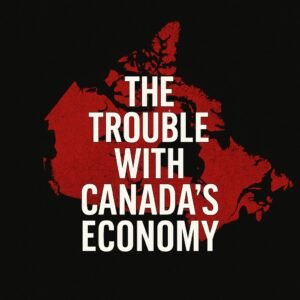Canada’s economy looks impressive on paper. The country ranks among the world’s top 10 largest economies by GDP. It has abundant natural resources, high per capita income, and a progressive global reputation. Yet beneath this polished surface lies a more troubling reality.
Canada’s economy is struggling with slow growth, excessive regulation, and short-sighted policies. This isn’t a sudden crisis. Instead, it’s a gradual decline that threatens the country’s long-term prosperity.

The Energy Sector: Canada’s Biggest Missed Opportunity
The Numbers Behind Canada’s Energy Wealth
Canada’s oil and gas sector forms the backbone of the country’s economy. In 2023, energy exports generated over $150 billion in revenue. This makes energy the single largest contributor to Canada’s trade surplus.
The sector employs over 200,000 people directly. It supports another 550,000 jobs indirectly across the supply chain. In Alberta alone, the energy sector contributes 16% of the province’s GDP.
Policy Obstacles Blocking Growth
Despite this economic importance, Canada’s government treats the energy sector like a problem to solve rather than an asset to leverage. Environmental regulations lack clear timelines but impose strict restrictions. Major pipeline projects face years of delays or outright cancellations.
The Trans Mountain Pipeline expansion took 11 years to complete. It faced numerous court challenges and regulatory reviews. The original budget of $5.4 billion ballooned to over $30 billion.
Meanwhile, competitors are moving fast. The United States has become the world’s largest LNG exporter. Norway continues expanding its energy infrastructure. Qatar is investing billions in new LNG facilities.
Canada’s LNG Canada project won’t be fully operational until 2025. By then, global competitors will have captured market share that Canada could have owned.
The Cost of Delayed Development
This regulatory paralysis has real economic consequences. Foreign investment in Canada’s energy sector dropped 50% between 2014 and 2019. Companies like Shell, Chevron, and ConocoPhillips have sold Canadian assets and redirected investment elsewhere.
The result? Canada’s economy loses billions in potential revenue. Workers lose high-paying jobs. Provincial governments lose tax revenue that could fund healthcare and education.

Housing Crisis: When Supply Meets Unstoppable Demand
The Immigration and Housing Math Problem
Canada’s housing crisis stems from a simple math problem. In 2023, Canada welcomed over 1.2 million new residents through immigration and temporary programs. This includes 465,000 permanent residents and over 800,000 temporary residents.
Housing starts in 2023 totaled just 270,000 units. This means Canada added 4.4 new residents for every new home built. The housing shortage grows worse each month.
The True Cost of Housing Delays
Building new housing in Canada takes an average of 18-24 months longer than in other developed countries. Municipal approval processes often take 12-18 months before construction can begin.
Toronto requires up to 23 different permits for a single residential project. Vancouver’s development approval process averages 16 months. These delays add $100,000-$200,000 to the cost of each new home.
Regional Housing Market Breakdown
The housing crisis varies by region, but it affects Canada’s economy nationwide:
Toronto Area: Average home price reached $1.1 million in 2023. Young professionals earning $80,000 annually and saving 10% per year would need to save for 28 years to afford a 20% down payment.
Vancouver: Home prices average $1.3 million. Rental vacancy rates sit at just 1.2%, driving average rent for a one-bedroom apartment to $2,400 monthly.
Calgary: Despite lower absolute prices, homes still cost 5.2 times the median household income. This ratio indicates poor affordability compared to historical norms.
The housing shortage forces skilled workers to leave major cities. Companies struggle to attract talent. Canada’s economy loses productivity as workers spend more time commuting from affordable areas.

Regulatory Gridlock: How Red Tape Strangles Growth
The True Cost of Overregulation
Canada’s regulatory environment ranks 23rd globally for ease of doing business. This puts it behind countries like Estonia, Lithuania, and South Korea. Major infrastructure projects face an average of 7-12 different regulatory reviews.
The federal Impact Assessment Act requires environmental reviews for most major projects. These reviews take an average of 4.5 years to complete. During this time, project costs increase due to inflation and regulatory uncertainty.
Case Study: The Coastal GasLink Pipeline
The Coastal GasLink pipeline project illustrates Canada’s regulatory challenges. The 670-kilometer pipeline received initial approval in 2014. Construction didn’t begin until 2019 due to regulatory delays and legal challenges.
The project’s budget increased from $6.2 billion to over $14 billion. Much of this increase resulted from regulatory delays, not construction costs. The pipeline was originally scheduled for completion in 2023. It’s now expected to finish in 2025.
Productivity Consequences
These regulatory delays have measurable economic impacts. Canada’s business productivity growth averaged just 0.1% annually between 2015-2022. This compares to 1.2% in the United States and 0.8% across the OECD.
Lower productivity means Canadian workers earn less relative to their international peers. It means Canadian companies struggle to compete globally.
The Monopoly Problem: Why Canadians Pay More
Telecommunications: A Protected Oligopoly
Canada’s telecommunications sector demonstrates how a lack of competition hurts the economy. Three companies—Rogers, Bell, and Telus—control 90% of the wireless market.
Canadian families pay an average of $101 monthly for wireless service. American families pay $55 for comparable service. This means the average Canadian household pays $552 more annually for cell phone service.
Over 15 million Canadian households, this represents $8.3 billion in excess costs annually. This money could otherwise be spent on housing, education, or business investment.
Banking: The Big Five’s Grip
Canada’s banking sector shows similar concentration. Five banks control over 90% of assets: RBC, TD, BMO, Scotiabank, and CIBC.
Canadian banks charge higher fees than most international peers. The average Canadian pays $185 annually in banking fees. Americans pay $97. Europeans pay even less due to stronger competition.
In fact, Canada ranks #2 globally in most profitable banking sectors (per capita) due to fee concentration.
Grocery Retail: Limited Choice, Higher Prices
Three companies control 75% of Canada’s grocery market: Loblaws, Metro, and Sobeys. Food prices in Canada increased 11.4% in 2022, compared to 8.5% in the United States.
The Competition Bureau found that grocery concentration likely contributes to higher food prices. Limited competition reduces incentives for efficiency and innovation.

Demographics and Productivity: The Growth Illusion
Population Growth vs. Economic Growth
Canada’s economy grew 1.5% in 2023. This sounds impressive until you account for population growth. Canada’s population increased 3.2% in 2023—the fastest rate in 65 years.
Per capita GDP actually declined in 2023. This means the average Canadian became slightly poorer despite overall economic growth. Canada’s economy is adding people faster than it’s adding value.
The Skills and Infrastructure Gap
Canada’s rapid population growth strains existing infrastructure. Public transit systems in Toronto and Vancouver operate at capacity during peak hours. Healthcare wait times increased as the population grew faster than healthcare capacity.
New immigrants often struggle to get professional credentials recognized. A 2023 study found that 24% of recent immigrants with university degrees work in jobs that don’t require post-secondary education.
This skills underutilization hurts Canada’s economy. It wastes human capital and reduces overall productivity growth.
Comparing Canada to Peer Countries
Canada’s economic performance lags other developed nations:
- GDP per capita growth (2019-2023): Canada -0.3%, United States +4.2%, Australia +2.1%
- Productivity growth (2015-2022): Canada 0.1%, United States 1.2%, Germany 0.6%
- Business investment as % of GDP: Canada 13.2%, United States 17.8%, OECD average 16.1%
These numbers show that Canada’s economy is falling behind its peers in key measures of prosperity.
The Path Forward: What Canada’s Economy Needs
Immediate Reforms Required
Canada’s economy needs structural reforms to regain competitiveness:
Regulatory Reform: Streamline environmental assessments. Set firm timelines for regulatory decisions. Create a “one-stop shop” for major project approvals.
Housing Supply: Override municipal zoning restrictions. Fast-track approval for high-density housing. Invest in infrastructure to support population growth.
Competition Policy: Break up telecommunications oligopolies. Reduce barriers to entry in banking and retail. Strengthen the Competition Bureau’s enforcement powers.
Long-term Economic Strategy
Canada’s economy needs a clear strategy for the next decade:
- Leverage Natural Resources: Build LNG export capacity. Develop critical minerals mining. Export clean energy to international markets.
- Improve Productivity: Invest in digital infrastructure. Support business innovation. Reform immigration to focus on economic needs.
- Build Infrastructure: Expand public transit. Upgrade electrical grids. Create economic corridors between major cities.
Conclusion: Canada’s Economic Crossroads
Canada’s economy stands at a crossroads. The country can continue coasting on past success while problems compound. Or it can make difficult reforms to restore competitiveness.
The choice will determine whether Canada remains prosperous or slowly declines into comfortable mediocrity. The data shows that without changes, Canada’s economy will continue falling behind international competitors.
Canadians deserve better than managed decline. Canada’s economy has the resources and talent to thrive. It needs leaders willing to make tough decisions and implement real reforms, especially in light of recent economic uncertainty.
The time for half-measures has passed. Canada’s economy needs fundamental change to secure its future prosperity.





